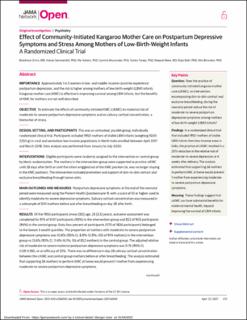| dc.contributor.author | Sinha, Bireshwar | |
| dc.contributor.author | Sommerfelt, Halvor | |
| dc.contributor.author | Ashorn, Per | |
| dc.contributor.author | Mazumder, Sarmila | |
| dc.contributor.author | Taneja, Sunita | |
| dc.contributor.author | More, Deepak | |
| dc.contributor.author | Bahl, Rajiv | |
| dc.contributor.author | Bhandari, Nita | |
| dc.date.accessioned | 2022-01-26T13:13:42Z | |
| dc.date.available | 2022-01-26T13:13:42Z | |
| dc.date.created | 2021-09-17T09:20:32Z | |
| dc.date.issued | 2021 | |
| dc.identifier.issn | 2574-3805 | |
| dc.identifier.uri | https://hdl.handle.net/11250/2839465 | |
| dc.description.abstract | Importance Approximately 1 in 5 women in low- and middle-income countries experience postpartum depression, and the risk is higher among mothers of low-birth-weight (LBW) infants. Kangaroo mother care (KMC) is effective in improving survival among LBW infants, but the benefits of KMC for mothers are not well described.
Objective To estimate the effects of community-initiated KMC (ciKMC) on maternal risk of moderate-to-severe postpartum depressive symptoms and on salivary cortisol concentration, a biomarker of stress.
Design, Setting, and Participants This was an unmasked, parallel-group, individually randomized clinical trial. Participants included 1950 mothers of stable LBW infants (weighing 1500-2250 g) in rural and semiurban low-income populations in North India enrolled between April 2017 and March 2018. Data analysis was performed from January to July 2020.
Interventions Eligible participants were randomly assigned to the intervention or control group by block randomization. The mothers in the intervention group were supported to practice ciKMC until 28 days after birth or until the infant wriggled out of the KMC position (ie, was no longer staying in the KMC position). The intervention included promotion and support of skin-to-skin contact and exclusive breastfeeding through home visits.
Main Outcomes and Measures Postpartum depressive symptoms at the end of the neonatal period were measured using the Patient Health Questionnaire–9, with a score of 10 or higher used to identify moderate-to-severe depressive symptoms. Salivary cortisol concentration was measured in a subsample of 550 mothers before and after breastfeeding on day 28 after birth.
Results Of the 1950 participants (mean [SD] age, 23 [3.5] years), outcome assessment was completed for 974 of 1047 participants (93%) in the intervention group and 852 of 903 participants (94%) in the control group. Sixty-four percent of participants (1175 of 1826 participants) belonged to the lowest 3 wealth quintiles. The proportion of mothers with moderate-to-severe postpartum depressive symptoms was 10.8% (95% CI, 8.9%-12.9%; 105 of 974 mothers) in the intervention group vs 13.6% (95% CI, 11.4%-16.1%; 116 of 852 mothers) in the control group. The adjusted relative risk of moderate-to-severe maternal postpartum depressive symptoms was 0.75 (95% CI, 0.59-0.96), or an efficacy of 25%. There was no difference in day-28 salivary cortisol concentration between the ciKMC and control group mothers before or after breastfeeding. The analysis estimated that supporting 36 mothers to perform KMC at home would prevent 1 mother from experiencing moderate-to-severe postpartum depressive symptoms.
Conclusions and Relevance These findings suggest that ciKMC practice may substantially reduce the risk of moderate-to-severe maternal postpartum depressive symptoms. This evidence supports KMC as an intervention to be incorporated in essential newborn care programs in low- and middle-income settings. | en_US |
| dc.language.iso | eng | en_US |
| dc.publisher | Jama | en_US |
| dc.rights | Navngivelse 4.0 Internasjonal | * |
| dc.rights.uri | http://creativecommons.org/licenses/by/4.0/deed.no | * |
| dc.title | Effect of Community-Initiated Kangaroo Mother Care on Postpartum Depressive Symptoms and Stress among Mothers of Low-Birth-Weight Infants: A Randomized Clinical Trial | en_US |
| dc.type | Journal article | en_US |
| dc.type | Peer reviewed | en_US |
| dc.description.version | publishedVersion | en_US |
| dc.rights.holder | Copyright 2021 The Author(s) | en_US |
| dc.source.articlenumber | e216040 | en_US |
| cristin.ispublished | true | |
| cristin.fulltext | original | |
| cristin.qualitycode | 1 | |
| dc.identifier.doi | 10.1001/jamanetworkopen.2021.6040 | |
| dc.identifier.cristin | 1935207 | |
| dc.source.journal | JAMA Network Open | en_US |
| dc.relation.project | Norges forskningsråd: 223269 | en_US |
| dc.identifier.citation | JAMA Network Open. 2021, 4 (4), 1-12. | en_US |
| dc.source.volume | 4 | en_US |
| dc.source.issue | 4 | en_US |

